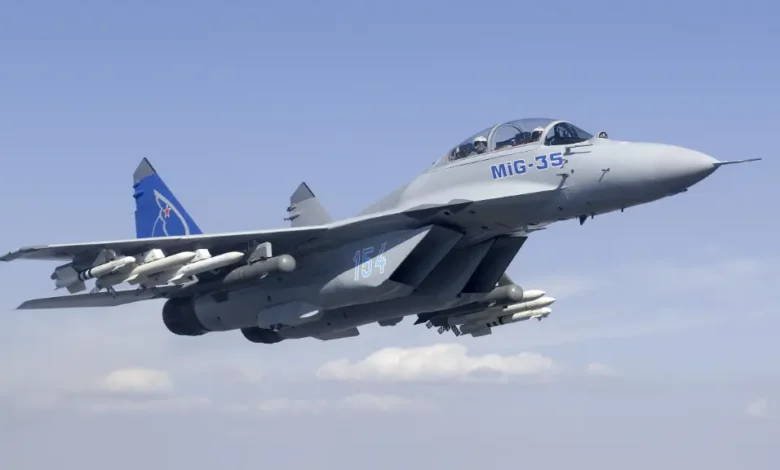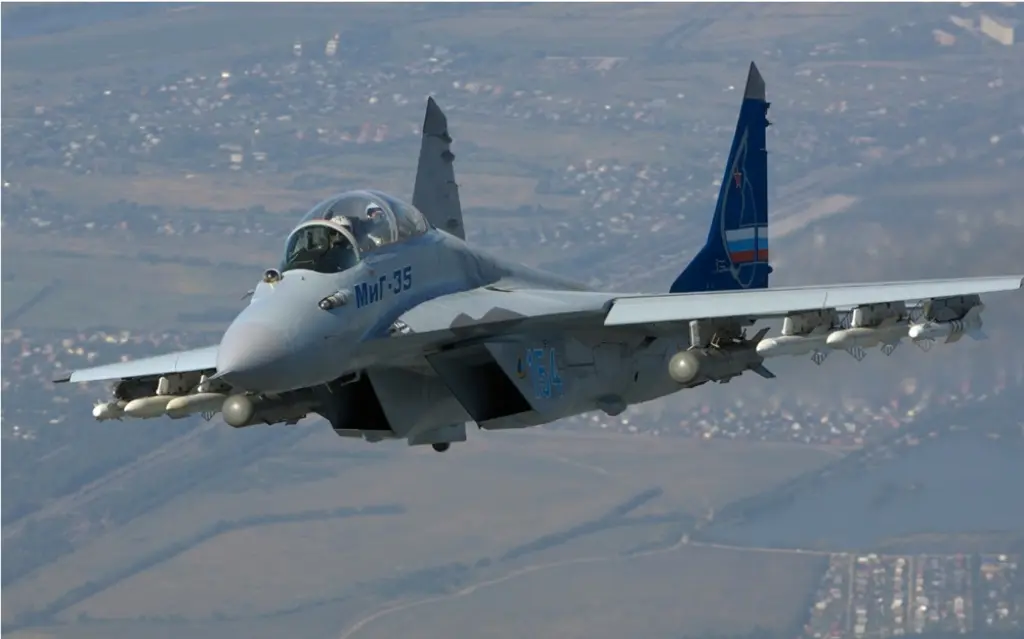Mikoyan MiG-35

The Mikoyan MiG-35 is a multirole fighter aircraft developed by Mikoyan, a division of the United Aircraft Corporation in Russia. First unveiled in 2007 and officially introduced in 2019, the MiG-35 is an advanced derivative of the MiG-29, featuring improved avionics, weapons systems, and reduced radar cross-section. It is designed for air superiority and precision strike missions, offering enhanced combat capabilities for modern warfare.
Fact Sheet
| Role | Multirole fighter |
|---|---|
| Manufacturer | Mikoyan (United Aircraft Corporation) |
| First Flight | 2007 |
| Service Entry | 2019 |
| Crew | 1 or 2 (depending on variant) |
Specifications
| Length | 17.3 m (56.8 ft) |
|---|---|
| Wingspan | 12 m (39.4 ft) |
| Height | 4.73 m (15.5 ft) |
| Empty Weight | 11,000 kg (24,250 lb) |
| Max Takeoff Weight | 29,700 kg (65,480 lb) |
| Powerplant | 2 × Klimov RD-33MK turbofans |
| Thrust | 19,800 lbf (88 kN) per engine with afterburner |
| Max Speed | Mach 2.25 (2,400 km/h; 1,490 mph) |
| Service Ceiling | 17,500 m (57,400 ft) |
| Range | 1,240 mi (2,000 km) combat radius |
| Rate of Climb | ~65,000 ft/min (330 m/s) |
Avionics & Armament
| Main Radar | Zhuk-AE AESA radar |
|---|---|
| Avionics | Advanced avionics suite, electronic warfare systems |
| Armament | One 30-mm GSh-30-1 cannon (150 rounds); Up to 9 external hardpoints for: – Air-to-air missiles (R-77, R-73) – Air-to-ground munitions (Kh-31, Kh-29, bombs) – Precision-guided bombs – External fuel tanks |
Notable Features
- Advanced avionics for superior situational awareness.
- Multirole capability for air-to-air and air-to-ground missions.
- Reduced radar cross-section for enhanced survivability.
- High maneuverability with thrust vectoring engines (optional).
- Designed for export markets and modernized combat scenarios.

The Russian “4++” Fighter: Understanding the Mikoyan MiG-35
When we talk about modern fighter jets, the discussion often turns to stealthy fifth-generation aircraft. However, there’s a significant category of highly advanced, non-stealth fighters known as “4++ generation” jets, which aim to deliver near-fifth-generation capabilities at a more affordable cost. One such aircraft is the Mikoyan MiG-35, often dubbed “Fulcrum-F” by NATO. It represents the pinnacle of the venerable MiG-29 “Fulcrum” family, packed with advanced technology to compete in today’s complex aerial landscape.
Let’s delve into the features and current status of this Russian multi-role fighter.
Evolving from a Legacy: The MiG-35’s Roots
The MiG-35 is a deep modernization of the well-known MiG-29M/M2 and MiG-29K/KUB fighters. Its development stemmed from Mikoyan’s efforts to offer a highly capable and versatile platform for both the Russian Aerospace Forces and for export customers. The first full-scale prototype (designated “31001”) made its maiden flight in 2012, with subsequent prototypes and pre-production models refining the design. The aircraft was officially unveiled to international audiences in 2007.
The “4++ generation” designation signifies that while it doesn’t possess the full stealth characteristics of a true fifth-generation fighter, it incorporates many advanced systems and features found on those more expensive aircraft, making it a formidable opponent.
Key Features: Bridging the Generational Gap
The MiG-35 is designed to be a highly versatile multi-role fighter, capable of performing a wide array of missions. Here are some of its defining characteristics:
- Advanced Avionics and Sensor Fusion: This is where the MiG-35 truly steps into the modern era. It boasts an advanced avionics suite designed to give the pilot exceptional situational awareness. This includes:
- Active Electronically Scanned Array (AESA) Radar: The Zhuk-AE AESA radar is a significant upgrade over previous mechanically scanned radars. It can detect and track multiple air and surface targets simultaneously at long ranges (reportedly up to 160 km for air targets and 300 km for surface targets), offers improved resistance to jamming, and can perform high-resolution ground mapping.
- Optical Locator System (OLS-35): This unique, passive sensor combines an infrared search and track (IRST) system, a TV camera, and a multi-mode laser rangefinder. The OLS-35 allows the MiG-35 to detect targets without emitting any radar signals, making it extremely difficult for an enemy to detect the aircraft itself. It’s a crucial tool for stealthy engagements.
- Helmet-Mounted Targeting System: This allows the pilot to “look” at a target and lock weapons onto it simply by turning their head, enhancing close-range combat effectiveness.
- Digital Glass Cockpit: The pilot benefits from modern multi-function displays and a Head-Up Display (HUD), reducing pilot workload and presenting critical information clearly.
- Improved Performance and Maneuverability:
- Enhanced Engines: The MiG-35 is powered by two upgraded Klimov RD-33MK turbofan engines. These provide increased thrust (7% more than the baseline RD-33), improved fuel efficiency, and a reduced infrared signature. Crucially, they can be fitted with thrust-vectoring nozzles (often referred to as KliVT nozzles), giving the MiG-35 supermaneuverability, allowing it to perform extreme maneuvers like the “Cobra” and maintain control at high angles of attack.
- Increased Range: With a redesigned internal fuel system and the ability to carry larger external fuel tanks, the MiG-35’s ferry range has increased by approximately 50% compared to earlier MiG-29s, and can be extended further with in-flight refueling capability.
- Robust Airframe: The airframe incorporates lighter alloys and a redesigned center wingbox section, contributing to increased range and potential for heavier payloads.
- Multirole Capabilities: The “F” in “Fulcrum-F” truly signifies its multi-role nature. The MiG-35 can carry up to 6.5 tons of weaponry on its nine hardpoints, including:
- Air-to-Air Missiles: A variety of Russian air-to-air missiles, including short-range R-73/74 (infrared-guided) and medium-range R-77/R-77M (radar-guided, including the new Izdelie 810 with an AESA seeker and a range over 300km).
- Air-to-Ground Munitions: A wide range of precision-guided munitions such as Kh-31 anti-ship and anti-radiation missiles, Kh-29 air-to-surface missiles, and KAB-500 series TV-guided and laser-guided bombs. It can also carry unguided bombs and rockets.
- Internal 30mm Cannon: For close-range engagements, it retains the powerful 30mm GSh-30-1 cannon.
- Electronic Warfare Suite: The MiG-35 is designed to incorporate a powerful electronic warfare (EW) suite, possibly derived from the Su-57’s “Himalayas” system, to interfere with enemy targeting systems and enhance its survivability.
Operational Status and Challenges
As of mid-2025, the Mikoyan MiG-35‘s journey has been somewhat tumultuous. While touted as a flagship export product and a potential successor for lighter fighter roles in the Russian Aerospace Forces, its production numbers have been very low. Only a handful of pre-series aircraft (around six) were delivered to the Russian Aerospace Forces in 2019.
Despite initial high hopes for export orders (with countries like Egypt and India considering it), the MiG-35 has struggled to secure major international buyers. This is due to several factors, including competition from established Western and Chinese alternatives, the aircraft’s initial development delays, and more recently, the impact of the ongoing conflict in Ukraine on Russia’s defense industry and export capabilities.
However, recent reports in early to mid-2025 suggest a renewed push by the Russian Ministry of Defense and United Aircraft Corporation to “revive” the MiG-35 program and increase its production on a significant scale. This renewed interest is largely driven by the need to replenish combat losses and rapidly modernize the Russian Aerospace Forces fleet with advanced, digitally integrated aircraft. Future upgrades are reportedly planned to integrate even more advanced technologies from the Su-57, further enhancing its combat potential, particularly with new long-range air-to-air missiles.
The Future of the “Fulcrum-F”
The Mikoyan MiG-35 represents a potent blend of traditional Russian fighter design (agility, robustness) with modern “4++ generation” avionics and weapons. While its path to widespread adoption has been challenging, the renewed focus on its production for domestic use, alongside continued efforts to promote it for export (even to new potential clients like North Korea and Belarus), indicates that the “Fulcrum-F” is not ready to fade away. It aims to be a cost-effective, highly capable multi-role fighter, serving as a valuable asset in air forces that prioritize advanced capabilities without the extreme costs associated with full fifth-generation stealth aircraft.



